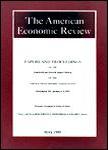-
作者:Aizcorbe, A
-
作者:Baicker, K; Chandra, A
作者单位:Dartmouth College; Dartmouth College; National Bureau of Economic Research
-
作者:Engelbrecht-Wiggans, R; List, JA; Reiley, DH
作者单位:University of Illinois System; University of Illinois Urbana-Champaign; University System of Maryland; University of Maryland College Park; University System of Maryland; University of Maryland College Park; University of Arizona
-
作者:Grossman, GM; Helpman, E; Szeidl, A
作者单位:Princeton University; Harvard University; University of California System; University of California Berkeley
-
作者:Solnick, SJ; Hemenway, D
作者单位:University of Vermont; Harvard University; Harvard T.H. Chan School of Public Health
-
作者:Walstad, WB; Allgood, S
作者单位:University of Nebraska System; University of Nebraska Lincoln
-
作者:Greenwood, J; Seshadri, A; Vandenbroucke, G
作者单位:University of Rochester; University of Wisconsin System; University of Wisconsin Madison; University of Southern California
摘要:What caused the baby boom? And can it be explained within the context of the secular decline infertility that has occurred over the last 200 years? The hypothesis is that: (a) The secular decline infertility is due to the relentless rise in real wages that increased the opportunity cost of having children; (b) The baby boom is explained by an atypical burst of technological progress in the household sector that occurred in the middle of the last century. This lowered the cost of having childre...
-
作者:Levin, D
作者单位:University System of Ohio; Ohio State University
-
作者:Meghir, C; Palme, M
作者单位:University of London; London School Economics & Political Science; University College London; University of London; University College London; Stockholm University; Linnaeus University; Vaxjo University
-
作者:Wynne, J
作者单位:Duke University
摘要:This paper shows that a country's wealth can be an important determinant of comparative advantage when access to credit differs across sectors of the economy. Wealthier nations exhibit a comparative advantage toward goods produced in sectors facing more severe financial imperfections. These sectors are typically populated by small firms. Empirically this paper documents that these sectors are also labor intensive. Consequently, this theory partially offsets traditional sources of comparative a...


